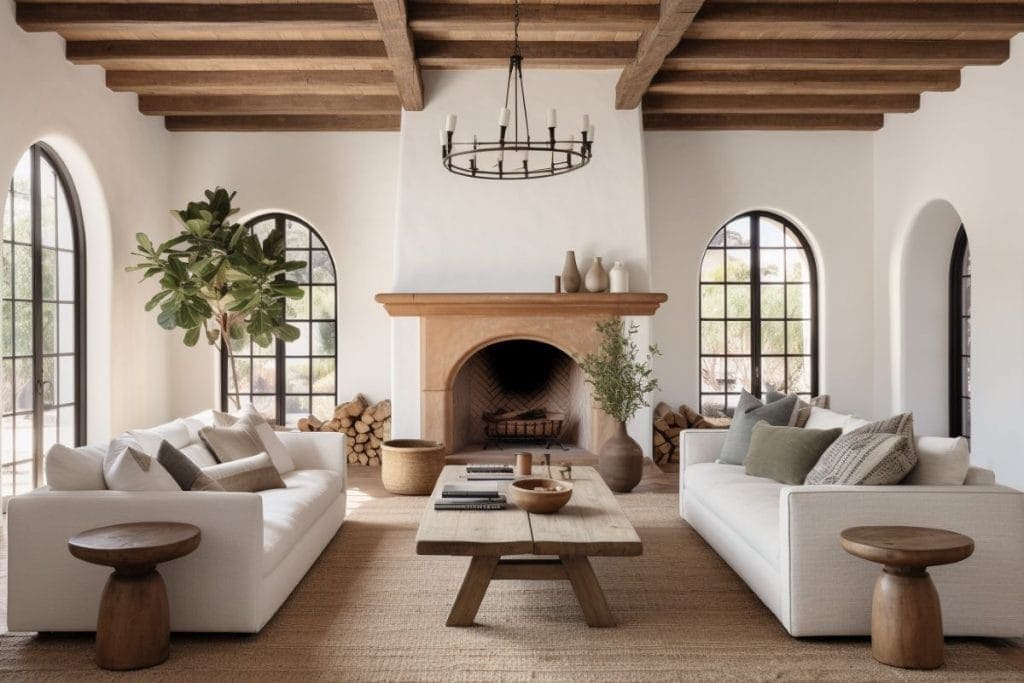Spanish style home interiors captivate with their timeless elegance, combining warmth and rustic charm with a touch of Mediterranean allure. This design style is characterized by its use of natural materials, handcrafted details, and vibrant colors, creating a welcoming and cozy atmosphere. In this comprehensive guide, we will explore the key elements that define Spanish style home interiors, providing you with the inspiration and knowledge to transform your living space into a beautiful Spanish retreat.
1. Architectural Features
Arched Doorways and Windows
One of the most recognizable features of Spanish style interiors is the use of arched doorways and windows. These graceful curves add a sense of elegance and flow to the space, creating a seamless transition between rooms. Often framed with natural wood or wrought iron, these arches are not only aesthetically pleasing but also functional, allowing more natural light to enter the home.
Exposed Wooden Beams
Exposed wooden beams are a hallmark of Spanish style interiors. These beams, typically made from dark, rich woods such as oak or walnut, add a rustic charm and architectural interest to ceilings. They contrast beautifully with white plaster walls, creating a striking visual effect that embodies the essence of Spanish design.
Tile Roofing and Terracotta Floors
The use of natural materials extends to the floors and roofs of Spanish style homes. Terracotta tiles, with their warm earthy tones, are commonly used for flooring, providing durability and a timeless appeal. Similarly, the iconic red tile roofing not only adds to the aesthetic but also helps keep the home cool during the hot Mediterranean summers.
2. Color Palette
Warm Earth Tones
Spanish interiors are known for their warm and inviting color palettes. Think of hues inspired by the sun-soaked landscapes of Spain—rich terracottas, soft yellows, deep reds, and burnt oranges. These colors are often complemented by neutral shades like beige, cream, and taupe, creating a harmonious and cozy environment.
Vibrant Accents
To add vibrancy and personality to the space, Spanish interiors incorporate bold accents. Bright blues, greens, and intricate tile patterns are used in moderation to infuse energy and character. These pops of color can be found in decorative elements such as ceramics, textiles, and artwork.
3. Natural Materials
Wood and Wrought Iron
Wood and wrought iron are integral materials in Spanish style interiors. From heavy wooden doors to ornate wrought iron railings and light fixtures, these materials add a rustic and handcrafted feel to the home. The combination of wood and iron creates a sense of strength and durability, reflecting the historical roots of Spanish design.
Clay and Terracotta
Clay and terracotta are use extensively in Spanish interiors, from flooring and roof tiles to pottery and decorative accents. These materials bring a sense of warmth and authenticity to the space, grounding the design in natural, earthy elements.
4. Decorative Details
Handcrafted Furniture
Furniture in Spanish style interiors is often handcrafte, featuring intricate carvings and sturdy construction. Pieces are typically made from dark woods and are designed to be both functional and beautiful. Look for tables, chairs, and cabinets with ornate details and a robust presence.
Colorful Textiles
Textiles play a crucial role in adding color and texture to Spanish interiors. Richly patterned rugs, vibrant throw pillows, and intricately woven blankets add layers of warmth and comfort. These textiles often feature traditional Spanish patterns and motifs, connecting the interior design to its cultural heritage.
Ornate Tile Work
Tiles are a signature element of Spanish design, used extensively in kitchens, bathrooms, and as decorative accents throughout the home. Hand-painted tiles with intricate designs add a touch of artistry and craftsmanship. Whether used as a backsplash or as part of a floor mosaic, these tiles contribute to the overall aesthetic and charm of Spanish interiors.
5. Outdoor Living Spaces
Courtyards and Patios
Spanish homes often feature beautiful outdoor living spaces that are seamlessly integrate with the interior. Courtyards and patios are designe for relaxation and entertaining, often adorne with lush plants, water fountains, and comfortable seating. These spaces extend the living area and provide a peaceful retreat that captures the essence of Mediterranean living.
Garden Elements
Gardens in Spanish style homes are lush and vibrant, filled with native plants, colorful flowers, and aromatic herbs. Terracotta pots, wrought iron furniture, and tiled pathways enhance the rustic charm. These garden elements create a serene and inviting atmosphere, perfect for enjoying the outdoors.
6. Lighting
Natural Light
Maximizing natural light is a key aspect of Spanish style interiors. Large windows, arched doorways, and open spaces allow sunlight to flood the rooms, creating a bright and airy feel. Light fabrics and reflective surfaces help to enhance this effect, making the space feel warm and welcoming.
Rustic Lighting Fixtures
In addition to natural light, Spanish interiors often feature rustic lighting fixtures made from wrought iron or bronze. Chandeliers, wall sconces, and lanterns with intricate designs add to the old-world charm. These fixtures not only provide illumination but also serve as decorative elements that enhance the overall aesthetic.
7. Conclusion
Embracing the rustic charm of Spanish style home interiors involves a careful balance of natural materials, warm colors, and handcrafted details. By incorporating elements such as arched doorways, exposed wooden beams, terracotta floors, and vibrant textiles, you can create a space that is both inviting and timeless. Whether you are renovating an existing home or designing a new one, the key elements of Spanish style interiors will help you achieve a beautiful and cohesive design that celebrates the rich cultural heritage and rustic elegance of Spain.


